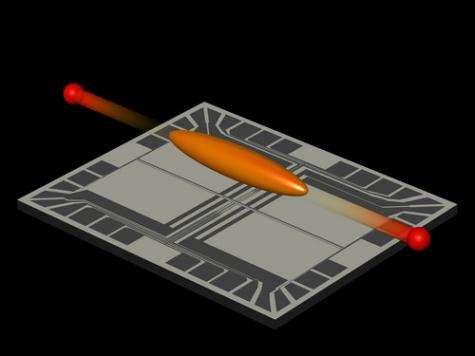An ultra cold Bose-Einstein condensate emits pairs of atoms in an atom-chip.
At the Vienna University of Technology, sophisticated atomchips have been used to create pairs of quantum mechanically connected atom-twins. Until now, similar experiments were only possible using photons.
Objects that are well separated in space but still cannot be understood separately belong to the profoundest mysteries of quantum physics. Pairs of photons are prominent examples of such systems. They allow the teleportation of quantum states or tap-proof data transfer using quantum cryptography. In future, such experiments will not be restricted simply to photons: at the Vienna University of Technology (TU Vienna), a method has been developed to create correlated pairs of atoms using ultracold Bose-Einstein condensates. The results of the experiments have now been published in the journal Nature Physics.
Even Einstein did not like the idea of well-separated particles still being quantum mechanically connected. He called this phenomenon “spooky action at a distance”. However, since then, the startling predictions of quantum theory have been verified in countless experiments. Quantum particles can – even if they are far apart – still belong together and “share” certain physical properties. “This does not mean that by manipulating one particle we can at the same time change the other, as if they were connected by an invisible thread”, Professor Jörg Schmiedmayer (TU Vienna) says, “but still, we have to treat both particles as one single quantum system – and that opens the door to fascinating new experiments.” Jörg Schmiedmayer’s team at the Institute for Atomic and Subatomic Physics, TU Vienna carried out the experiments, while theoretical calculations were done by Ulrich Hohensteiner (Karl Franzens University, Graz, Austria).
In order to produce the quantum-correlated atoms, the scientists first create a Bose-Einstein condensate. This exotic state of matter occurs at extremely low temperatures, at less than a millionth of a degree above absolute zero. In a Bose-Einstein condensate, the atoms are in the lowest possible energy state. “The key to success are our atomchips”, Thorsten Schumm (TU Vienna) explains. With perfectly tailored chip structures, atoms can be manipulated with incredible precision. It is possible to deliver single quanta of vibrational energy to the atoms of the ultracold Bose-Einstein condensate. When the atoms return to the lowest energy state, the condensate has to get rid of the surplus energy. “Because of the sophisticated design of our atomchips, the Bose-Einstein condensate is left with only one single way to dispose of its energy: emitting pairs of atoms. All other possibilities are forbidden by quantum mechanics”, Robert Bücker (TU Vienna) explains. According to the law of momentum conservation, the two atoms move in exactly opposite directions. This process is closely related to effects in special optical crystals, in which pairs of photons can be created (so-called “optical parametric oscillators”), but now massive particles can be used instead of light.
The emitted twin atoms cannot be understood in the same way as classical particles, such as debris scattered into all directions in an explosion. They are quantum mechanical copies of each other and only differ by their direction of motion. They form one common quantum object. One atom cannot be mathematically described without also describing the other. “We are going to use these atoms for exciting new experiments”, Schmiedmayer enthuses. “A fascinating new field of research is opening up which new insights and possible applications will evolve from. This cannot yet be foreseen. It is conceivable that these correlated atom beams will lead to new quantum measurement methods, with a precision far beyond the scope of classical physics.”
More information: R. Bücker et al., Twin-atom beams, Nature Physics, Advance Online Publication 01 May 2011. doi:10.1038/nphys1992
Abstract
In recent years, substantial progress has been made in exploringand exploiting the analogy between classical light and matter waves for fundamental investigations and applications1. Extending this analogy to quantum matter-wave optics is promoted by the nonlinearities intrinsic to interacting particles and is a stepping stone towards non-classical states2, 3. In light optics, twin-photon beams4 are a key element for generating the non-local correlations and entanglement required for applications such as precision metrology and quantum communication5. Similar sources for massive particles have so far been limited by the multi-mode character of the processes involved or a predominant background signal6, 7, 8, 9, 10, 11, 12, 13. Here we present highly efficient emission of twin-atom beams into a single transversal mode of a waveguide potential. The source is a one-dimensional degenerate Bose gas14 in the first radially excited state. We directly measure a suppression of fluctuations in the atom number difference between the beams to 0.37(3) with respect to the classical expectation, equivalent to 0.11(2) after correcting for detection noise. Our results underline the potential of ultracold atomic gases as sources for quantum matter-wave optics and should enable the implementation of schemes previously unattainable with massive particles.
Provided by Vienna University of Technology






















